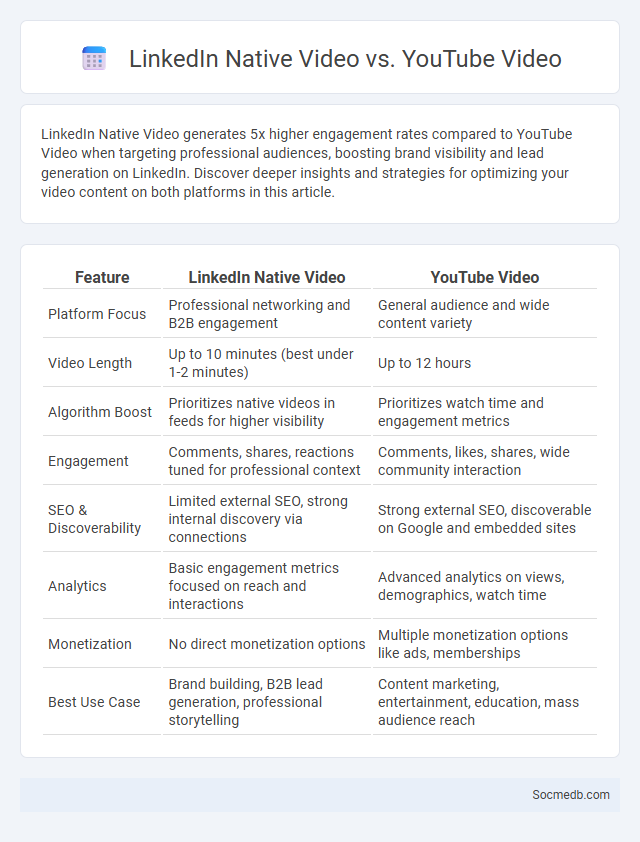
Photo illustration: LinkedIn Native Video vs YouTube Video
LinkedIn Native Video generates 5x higher engagement rates compared to YouTube Video when targeting professional audiences, boosting brand visibility and lead generation on LinkedIn. Discover deeper insights and strategies for optimizing your video content on both platforms in this article.
Table of Comparison
| Feature | LinkedIn Native Video | YouTube Video |
|---|---|---|
| Platform Focus | Professional networking and B2B engagement | General audience and wide content variety |
| Video Length | Up to 10 minutes (best under 1-2 minutes) | Up to 12 hours |
| Algorithm Boost | Prioritizes native videos in feeds for higher visibility | Prioritizes watch time and engagement metrics |
| Engagement | Comments, shares, reactions tuned for professional context | Comments, likes, shares, wide community interaction |
| SEO & Discoverability | Limited external SEO, strong internal discovery via connections | Strong external SEO, discoverable on Google and embedded sites |
| Analytics | Basic engagement metrics focused on reach and interactions | Advanced analytics on views, demographics, watch time |
| Monetization | No direct monetization options | Multiple monetization options like ads, memberships |
| Best Use Case | Brand building, B2B lead generation, professional storytelling | Content marketing, entertainment, education, mass audience reach |
Understanding LinkedIn Native Video: Key Features and Audience
LinkedIn native video integrates seamlessly within the platform, boosting engagement by autoplaying in user feeds and supporting captions for accessibility. Key features include detailed analytics that track viewer demographics, watch time, and interaction rates to optimize content strategies. This format primarily targets professionals seeking industry insights, networking opportunities, and thought leadership, making it essential for B2B marketers aiming to enhance brand authority.
YouTube Video: Platform Strengths and Global Reach
YouTube video content benefits from the platform's vast global reach, with over 2 billion logged-in monthly users engaging with diverse topics worldwide. Its robust algorithm enhances content discoverability, enabling creators to connect with target audiences effectively and boost viewer retention. By leveraging YouTube's powerful analytics and monetization options, Your videos can achieve greater visibility and sustained growth across international markets.
What is Native Video? Definition and Social Platforms
Native video refers to video content that is uploaded directly to a social media platform rather than shared via external links, ensuring higher engagement through optimized algorithms. Platforms like Facebook, Instagram, Twitter, and LinkedIn prioritize native videos by enabling auto-play and better visibility in users' feeds, which boosts organic reach. This format improves user experience by allowing seamless playback and interactive features, making native video a critical tool for social media marketing strategies.
Audience Engagement: LinkedIn vs YouTube vs Native Video
LinkedIn drives audience engagement through professional networking and targeted content distribution, fostering meaningful B2B interactions and thought leadership. YouTube excels in visual storytelling with its vast user base, leveraging video SEO and algorithmic recommendations to maximize reach and viewer retention. Native video on platforms like Facebook and Instagram boosts engagement by integrating seamlessly into user feeds, encouraging organic sharing and real-time interaction.
Video Algorithm Insights: LinkedIn, YouTube, and Native Platforms
Understanding video algorithm insights on LinkedIn, YouTube, and native social media platforms helps optimize your content visibility and audience engagement. LinkedIn favors professional, educational videos with higher watch times and meaningful interactions, while YouTube prioritizes content based on viewer retention, click-through rates, and regular uploads. Native platforms like Instagram and Facebook emphasize immediate engagement metrics such as likes, shares, and comments, rewarding authentic, relatable videos tailored to their user communities.
Branding and Professional Positioning on Each Platform
Social media platforms offer unique opportunities for branding and professional positioning tailored to their specific audiences and features. You can leverage LinkedIn to establish thought leadership and network with industry professionals, while Instagram excels at visual storytelling to build a personal or corporate brand identity. Twitter enables real-time engagement and trend participation, helping you maintain an authoritative voice within your niche.
Analytics and Performance Metrics Comparison
Analyzing social media analytics and performance metrics reveals critical insights into audience engagement, content effectiveness, and ROI across different platforms like Facebook, Instagram, and Twitter. You can track key indicators such as reach, impressions, click-through rates, and follower growth to optimize your marketing strategy. Comparing these metrics allows for data-driven decisions that improve brand visibility and campaign success.
Content Formats and Best Practices by Platform
Each social media platform favors distinct content formats such as short videos on TikTok, high-quality images on Instagram, and LinkedIn articles for professional audiences. Optimizing your content to fit platform-specific best practices, like using hashtags on Instagram or engaging questions on Facebook, boosts visibility and audience interaction. Understanding these nuances helps you tailor your content strategy to maximize reach and engagement effectively.
Lead Generation and Conversion Potential
Social media platforms offer powerful tools for lead generation by enabling precise audience targeting and engagement through content tailored to user interests. Leveraging analytics and targeted advertising, your campaigns can convert followers into qualified leads, boosting conversion rates significantly. Optimizing your social media strategy enhances brand visibility and drives higher ROI by turning interactions into actionable sales opportunities.
Choosing the Right Platform for Your Video Strategy
Selecting the ideal social media platform for your video strategy hinges on understanding audience demographics and content preferences. Platforms like YouTube excel for long-form educational videos, while Instagram and TikTok favor short, engaging clips that appeal to younger users. Prioritizing platform-specific features such as Instagram Reels or TikTok trends maximizes reach and engagement, aligning content with user behavior and algorithmic benefits.
 socmedb.com
socmedb.com